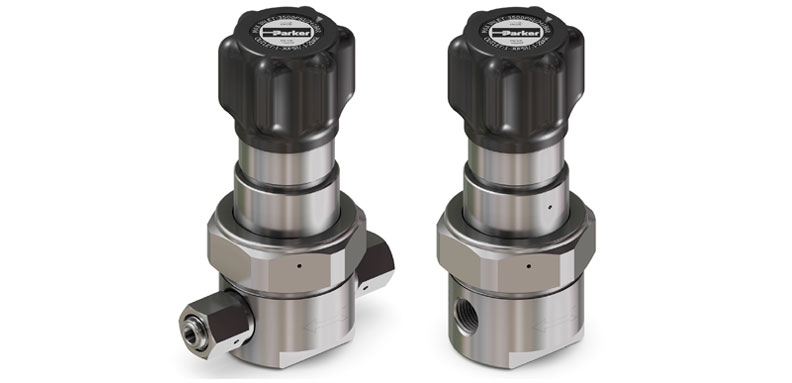There is a considerable amount of thought that goes into specifying a regulator, and it has everything to do with application. Specifically, what are the conditions in the application in which the actuator is earmarked for? Not all actuators are built equally, and depending on their intended use, one kind of actuator may be the clear choice.
Why is this so important?
By introducing a contaminant in a manufacturing process, there is the potential of damage to the downstream equipment. This means that a regulator’s construction and performance have as much of an impact as the process conditions needed to size it.
The three biggest elements to consider when specifying a regulator are process conditions, regulator construction and regulator performance.
Now, process conditions can be further divided into five main parts: Temperature, media, end connections, pressure, and flow.
Parker Veriflo FR/FRN1000 Series UHP Single Stage Pressure Reducing Regulator
High temperatures can cause deformation of the elastomer seals within a regulator. You’ll need to know that the seals in the regulator you’re selecting can handle the temperature it will ultimately be operating within.
The media flowing through the process can also cause problems depending on its nature. The regulator material must be compatible with said media. Everything from the body to the seals must be able to handle the media in order to avoid leaks and safety concerns.
End connections matter too. Applications generally call for metal-metal face seal or tube-end connections to minimize the probability of leaking across the seal.
Pressure is a bit more complicated as it applies to both inlet and outlet. Most manufacturer literature will list a given outlet pressure rise per 100 psi decrease in supply pressure. Outlet pressure, alternatively, is determined by the range spring used inside the body. Manufacturers will typically list these pressure ranges to assist in selection.
Flow is the last process condition. The C
v spec of a regulator is representative of the flow through the regulator at its fully open state. This is particularly significant as regulator C
v considerations are different than valve C
v considerations. It is critical to check with the manufacturer provided flow curve to verify the flow range for the application is appropriate for the regulator in question.
After we understand the process conditions, we must look at the regulator construction. For media compatible with stainless-steel/metal-alloy manufactured regulators, there are two main manufacturing processes: forged and bar stock construction. Ultra-high-pressure applications should use a bar stock constructed body. For more corrosive applications, it may be appropriate to use a polymer body.
Last, but not least is performance. Specifically, we need to understand droop – a phenomenon that occurs when there is a decrease in outlet pressure as the flow increases through a regulator. Managing droop is critical. If not done properly, there can be choked flow throughout the regulator.
I went into more detail about this topic in
my article published in Process Instrumentation last year. I would recommend giving it a read if you haven’t. And remember, the next time you need a regulator, make sure you understand all the elements that may affect your decision.
